The first sight of the citadel (the abbey of Monte Cassino) conjures up thoughts of a medieval castle - stark, unyielding, forbidding, square. But what a location! Visible from 30+ miles around. To say it dominates is an understatement. It towers, it broods, it enters the mind and occupies it. It makes you keep checking where you are in relation to it, knowing it’s still there - watching you.
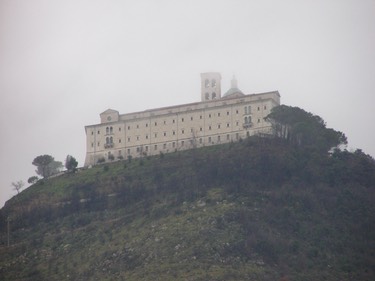
There is also an element of improbability. It's so high up, so white. It looks as though it must have flown there, like a palace in the Arabian Nights. Another reason to check whether it’s still there.
In the morning it's half hidden in cloud. The cloud clears briefly and we can see it, but then suddenly the abbey has gone again taking the mountain with it.
We approach the abbey through clouds full of rain that sweep across the mountain. It's thick rain inclining towards sleet. Eight hairpin bends, each numbered, record our climb from the town of Cassino, which is mapped so clearly below including the dramatic straightness of the old Roman road - in 1943 it was Highway 6 but previously it was the Via Casilina. As we ascend, the town slowly loses focus until it's hidden by the clouds.
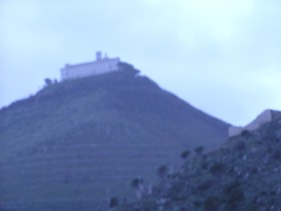
The higher hills around - when visible - are lightly dusted with snow creating an eerie light that's unnaturally bright beneath the leaden sky. The mountains press together, crowding to fill the space. Only the rivers hold them back leaving narrow valleys. But still the mountains stretch out their arms as though hoping to reach each other.
We approach the citadel up a ramp, above which the walls stretch upwards for 40 feet. Small uniform blocks of almost white stone complement the military style of the structure. At the top of the ramp hangs a massive grey door, 20 foot tall, above which is written PAX in red letters. The door is closed and brings no feeling of peace. We walk to the corner of the citadel and see another massive facade, measured by the rows of windows - 20 or 30 along. The rain pours down sending slow waves washing along the path.
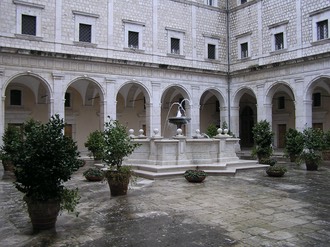
The real entrance does not order PAX; it’s more human in scale and open. Once in the gateway (and out of the rain) the path continues to rise and suddenly we’re in a cloister full of light. The stone seems whiter, the columns are slender, the cloister garden is tended and the sodden camellias are in flower; red, deep blood red.
Cloisters are designed to cope with weather. As the rain pours down and the temperature falls towards freezing, it's still comfortable to walk within them. The rain that is so oppressive outside becomes refreshing, cleansing water, which flows, gushes or drips onto every surface - washing, purifying, emptying. In case the rain proves insufficient, there are also fountains in the cloister gardens.
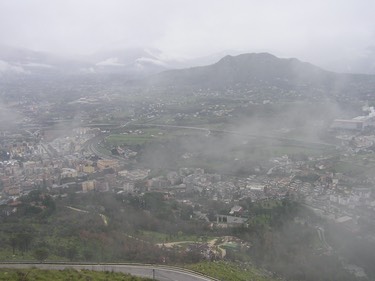
But not all of life is so cloistered. To reach the basilica we must climb the triumphal steps, forty feet wide, to reach the upper cloister that leads into the basilica. Military Christian orders like Knights Templar or the Knights of St John would proudly have taken refuge in this basilica. For there can be no doubt this is a place of power - not spiritual but temporal power.
It makes the contrast with the tawdry town of Cassino all the greater. Poor Cassino, a living monument to the unfairness of life. Cold, shabby, uncared for, it exists only as the servant of the mighty one that watches from above.

The Polish cemetery faces the abbey, reflecting the role the Poles played in taking Snakeshead Ridge and Point 593 before finally capturing the abbey itself. The graves form a crescent that gives a sense of unity. Men who were close to each other in life are now united in death. This is a religious place with many of the stone crosses hung with simple rosaries and crosses of small pebbles laid on the tombs.
The German cemetery is a hill with rows of graves around the hillside. At the top a grove of trees surrounds the central monuments. It seems appropriate that the German graves should occupy a hill, reflecting the nature of the campaign they fought, defending every hilltop.
The graves have small standing crosses with the names of three German soldiers carved on both sides of each stone; three to a grave - like overcrowded prison cells.
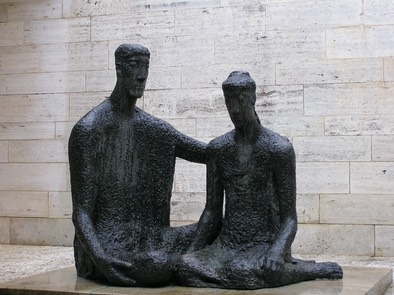
At the entrance to the German graveyard there’s a statue in black metal of two figures - a man and a woman sitting on the ground – both inconsolable with rain tears streaming down their faces. His left arm is raised to touch her shoulder but there is no warmth, no hope in this gesture. They are too far apart. He cannot comfort her. They are separated in their grief. His grief is for the loss of everything - empire, power, hope, friends. She has lost her family - and other things - but it’s the family that matters. The two will never be together in their grief.
The Commonwealth cemetery lies in the valley looking up the citadel but not dominated by it. It's astonishingly orderly with lines of symmetrical white gravestones. So many of them, so simple, so well cared for. There’s a gravestone for every man with his name, rank, date of birth, the carved emblem of his regiment and on almost every stone a personal inscription from his family - parents, wife, brothers, sisters, children - although some say simply "known unto God". Two things stand out. The personal quality; these were people who were loved. And the diversity; so many people from so many regiments from around the world. And the graves aren’t sorted by regiment or country but are mixed together.
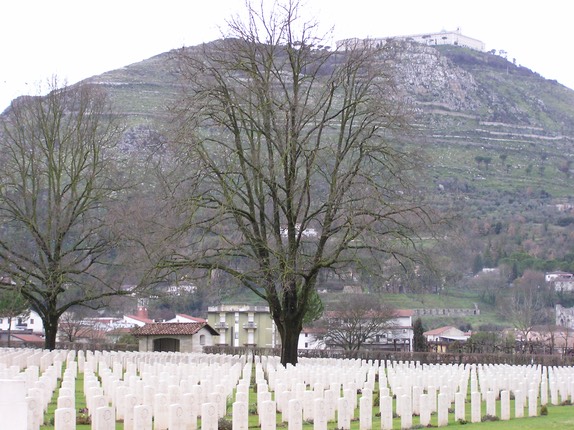
Also on each gravestone is a religious symbol; many crosses; some stars of David; some Hindu or Arabic inscriptions.
At the entrance to the cemetery is a broken column with an inscription in Italian saying it was given in 1947 with thanks by the town of Cassino. But this has not stopped large and ugly factories being built close to and overlooking the graveyard.